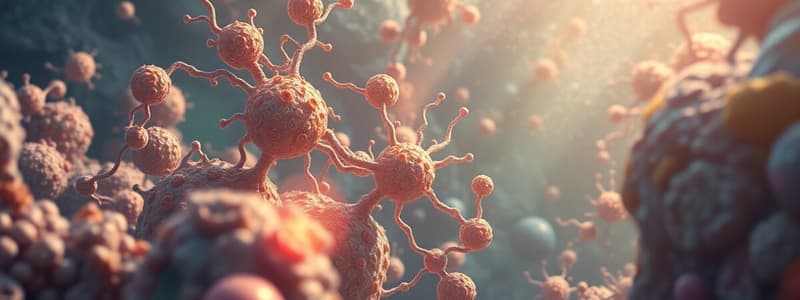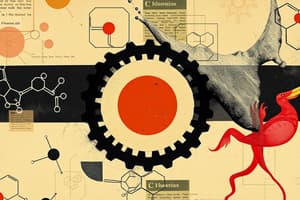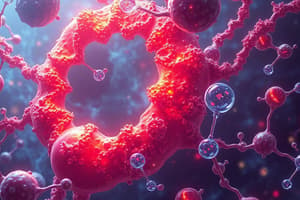Podcast
Questions and Answers
What is the primary benefit of a hierarchical structure in multicellular organisms?
What is the primary benefit of a hierarchical structure in multicellular organisms?
- It reduces the number of cells in the organism.
- It simplifies genetic variations.
- It decreases the organism's energy requirements.
- It enhances the ability for specialization. (correct)
Which of the following macromolecules is NOT mentioned as one of the main types in biological systems?
Which of the following macromolecules is NOT mentioned as one of the main types in biological systems?
- Carbohydrates
- Nucleic acids (correct)
- Proteins
- Fats
Why is carbon considered a fundamental element in living organisms?
Why is carbon considered a fundamental element in living organisms?
- It can create long chains and rings. (correct)
- It has the ability to form ions.
- It is the lightest element available.
- It is found in abundance in the universe.
How do living organisms typically acquire the elements necessary for life?
How do living organisms typically acquire the elements necessary for life?
What is one key element that makes up biological macromolecules?
What is one key element that makes up biological macromolecules?
Which of the following elements are primarily found in all living organisms?
Which of the following elements are primarily found in all living organisms?
What is the significance of the hierarchical structure in biological systems?
What is the significance of the hierarchical structure in biological systems?
Which of the following correctly describes the order of biological structures from smallest to largest?
Which of the following correctly describes the order of biological structures from smallest to largest?
What term describes the large molecules formed from smaller units in living organisms?
What term describes the large molecules formed from smaller units in living organisms?
Which of the following is NOT considered a type of macromolecule?
Which of the following is NOT considered a type of macromolecule?
What is an amino acid known to be in relation to proteins?
What is an amino acid known to be in relation to proteins?
Which amino acid is listed as an option in the context provided?
Which amino acid is listed as an option in the context provided?
What additional component is necessary to complete the amino acid structure when starting from glucose?
What additional component is necessary to complete the amino acid structure when starting from glucose?
What is the relationship between amino acids, proteins, and cells?
What is the relationship between amino acids, proteins, and cells?
In the hierarchical structure of life, what comes after proteins?
In the hierarchical structure of life, what comes after proteins?
What is the definition of hierarchy in the context provided?
What is the definition of hierarchy in the context provided?
Which term describes properties that only arise when components work together?
Which term describes properties that only arise when components work together?
How does hierarchy influence the functioning of organisms?
How does hierarchy influence the functioning of organisms?
What role do molecules play in the hierarchical structure of organisms?
What role do molecules play in the hierarchical structure of organisms?
What is meant by the phrase 'the sum of the parts' in hierarchical structures?
What is meant by the phrase 'the sum of the parts' in hierarchical structures?
In a hierarchical structure, what type of jobs are generally ranked lower?
In a hierarchical structure, what type of jobs are generally ranked lower?
What does the term 'organizational hierarchy' refer to?
What does the term 'organizational hierarchy' refer to?
What is one example provided to illustrate the concept of emergent properties?
What is one example provided to illustrate the concept of emergent properties?
What is the primary focus of a hierarchical structure in biological organisms?
What is the primary focus of a hierarchical structure in biological organisms?
Which of the following best describes emergent properties in organisms?
Which of the following best describes emergent properties in organisms?
How should components of a biological system be arranged in a hierarchical model?
How should components of a biological system be arranged in a hierarchical model?
What should groups do when creating a hierarchical model on a whiteboard?
What should groups do when creating a hierarchical model on a whiteboard?
Which term describes how specific organ systems maintain organism functionality?
Which term describes how specific organ systems maintain organism functionality?
What should be considered when selecting organs to demonstrate their interconnectivity?
What should be considered when selecting organs to demonstrate their interconnectivity?
What do annotated arrows represent in a mini-system model?
What do annotated arrows represent in a mini-system model?
What is the significance of excluding non-living components in a hierarchical model of living organisms?
What is the significance of excluding non-living components in a hierarchical model of living organisms?
What does the prefix 'macro' refer to in the context of macromolecules?
What does the prefix 'macro' refer to in the context of macromolecules?
Which main elements are represented by the acronym CHON?
Which main elements are represented by the acronym CHON?
What is the relationship between amino acids and proteins?
What is the relationship between amino acids and proteins?
Which of the following best describes the formation of complex carbohydrates?
Which of the following best describes the formation of complex carbohydrates?
What type of biological molecule is glucose classified as?
What type of biological molecule is glucose classified as?
How many covalent bonds can carbon atoms typically form?
How many covalent bonds can carbon atoms typically form?
Which combination of elements represents lipids?
Which combination of elements represents lipids?
What is a characteristic of macromolecules?
What is a characteristic of macromolecules?
Flashcards
Hierarchical Structure
Hierarchical Structure
The arrangement of parts within an organism, from the simplest to the most complex. This structure allows specialized functions to occur at different levels.
Emergent Properties
Emergent Properties
Properties that arise from the interaction of simpler components within a system, leading to new and unique functions.
Biological Macromolecules
Biological Macromolecules
Groups of atoms that form the basic building blocks of living organisms, like proteins, carbohydrates, and fats.
Transfer of Matter and Energy
Transfer of Matter and Energy
Signup and view all the flashcards
Carbon
Carbon
Signup and view all the flashcards
Hierarchy
Hierarchy
Signup and view all the flashcards
Macromolecule
Macromolecule
Signup and view all the flashcards
Organelle
Organelle
Signup and view all the flashcards
Tissue
Tissue
Signup and view all the flashcards
Organ
Organ
Signup and view all the flashcards
Organ System
Organ System
Signup and view all the flashcards
The Importance of Carbon
The Importance of Carbon
Signup and view all the flashcards
What is an atom?
What is an atom?
Signup and view all the flashcards
What is a molecule?
What is a molecule?
Signup and view all the flashcards
What is a cell?
What is a cell?
Signup and view all the flashcards
Hierarchical Structure in Biology
Hierarchical Structure in Biology
Signup and view all the flashcards
CHON Elements
CHON Elements
Signup and view all the flashcards
Why Carbon is Special
Why Carbon is Special
Signup and view all the flashcards
Organic Molecule
Organic Molecule
Signup and view all the flashcards
Valence
Valence
Signup and view all the flashcards
Amino Acids
Amino Acids
Signup and view all the flashcards
Protein
Protein
Signup and view all the flashcards
Lipids
Lipids
Signup and view all the flashcards
Carbohydrates
Carbohydrates
Signup and view all the flashcards
Glucose
Glucose
Signup and view all the flashcards
What is biosynthesis?
What is biosynthesis?
Signup and view all the flashcards
What are amino acids?
What are amino acids?
Signup and view all the flashcards
What is a protein?
What is a protein?
Signup and view all the flashcards
What is an organelle?
What is an organelle?
Signup and view all the flashcards
What is hierarchical structure?
What is hierarchical structure?
Signup and view all the flashcards
Study Notes
Unit 4: How to Maintain a Stable Existence?
- Biological systems function due to emergent properties arising from hierarchical structures within organisms.
- Living things use a limited set of elements to create building blocks and support life through transferring matter and energy.
- Multicellular organisms are made of hierarchical parts.
- Biological macromolecules like proteins, carbohydrates, and fats are composed of specific elements.
- Organisms obtain the elements needed to build these molecules through various processes.
- Carbon's unique structure makes it vital, especially within living organisms.
Hierarchical Organization of Organisms
- Living organisms are organized in a hierarchical manner, from atoms to biosphere.
- Hierarchical structure encompasses cells, tissues, organs, organ systems, and the organism itself.
- This organization allows specialization and complex functions.
- Non-living components are excluded from this organizational model.
- Interconnected systems carry out different functions via specialized systems (like circulatory system).
Macromolecules
- Atoms bond in predictable ways to form molecules making up macromolecules.
- Key molecules include carbohydrates (sugars), lipids (fats), proteins, and nucleic acids.
- These molecules are composed of specific chemical elements (C, H, O, N, S, P).
- Macromolecules form the basis of all living organisms.
Elementary Composition and Emergent Properties
- A limited number of atoms (carbon, hydrogen, oxygen, and nitrogen – CHON) form all living organisms.
- Emergent properties result from interactions among different components of a system, creating functions that individual parts don't possess..
Studying That Suits You
Use AI to generate personalized quizzes and flashcards to suit your learning preferences.



